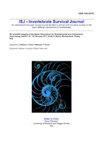Bacterial communities in gills and intestines of yesso scallop (Patinopecten yessoensis) and its habitat waters in Changhai (Dalian, China)
IF 1.2
4区 农林科学
Q4 IMMUNOLOGY
引用次数: 9
Abstract
Yesso scallop is a marine bivalve mollusc of economic importance in the coastline of northern China. The frequently outbreak of various diseases has heavily threatened the sustainable development of the scallop industry. The information about the bacterial communities inside and outside the body of Yesso scallop will provide insights into disease prevention, probiotic application and health aquaculture. In the present study, the diversity of bacterial communities in intestines, rectum and gills of Yesso scallop and its habitat waters were investigated. The bacterial diversity and richness in waters were higher than that in intestines, rectum and gills. The microbiota from intestines, rectum, gills of scallop and waters were clearly separated into four clusters by Non-metric multidimensional scaling and hierarchical cluster analysis, suggesting a microbiota selection of scallop at organ scale. Venn diagram suggested that the bacterial community in the body of scallop was more specialized than that in waters. High-throughput sequencing revealed that the main bacterial communities in intestine, rectum and gill were Firmicutes, Tenericute and Proteobacteria, Chlamydiae, Proteobacteria and Firmicutes, and Proteobacteria and Firmicutes, respectively. While the bacterial communities in waters mainly included Proteobacteria, Bacteroidetes and Cyanobacteria. Real-time PCR for bacterial load showed that the total bacterial abundance in waters was significantly higher than that inside the scallop body. The abundance of Bacteroides fragilis in rectum was significantly higher than that in intestines and gills. The results about the bacterial community inside and outside the body of Yesso scallop are helpful to better understand the relationship between the symbiotic bacteria of Yesso scallop and their habitat, and also provided critical information to develop strategies of disease prevention and probiotic application in scallop aquaculture.长海扇贝(Patinopecten yessoensis)鳃肠细菌群落及其栖息地水域
扇贝是中国北方沿海一种具有重要经济价值的海洋双壳类软体动物。各种病害的频繁爆发严重威胁着扇贝产业的可持续发展。对叶梭扇贝体内和体外细菌群落的了解将为疾病预防、益生菌应用和健康养殖提供新的见解。本研究对叶索扇贝的肠道、直肠和鳃及其栖息地水域的细菌群落多样性进行了研究。水中的细菌多样性和丰富度高于肠道、直肠和鳃。通过非度量多维尺度和层次聚类分析,将扇贝的肠道、直肠、鳃和水中的微生物群划分为4个簇,表明扇贝在器官尺度上存在微生物群选择。维恩图表明,扇贝体内的细菌群落比水中的细菌群落更加专门化。高通量测序结果显示,肠道、直肠和鳃的主要菌群分别为厚壁菌门(Firmicutes)、厚壁菌门(Tenericute and Proteobacteria)、衣原菌门(Chlamydiae)、变形菌门(Proteobacteria and Firmicutes)和变形菌门(Proteobacteria and Firmicutes)。水体细菌群落主要包括变形菌门、拟杆菌门和蓝藻门。实时荧光定量PCR检测结果显示,扇贝体内细菌总丰度显著高于水体。直肠中脆弱拟杆菌的丰度显著高于肠道和鳃。研究结果有助于更好地了解扇贝体内和体外的共生菌群与其栖息地的关系,并为制定扇贝养殖疾病预防和益生菌应用策略提供重要信息。
本文章由计算机程序翻译,如有差异,请以英文原文为准。
求助全文
约1分钟内获得全文
求助全文
来源期刊

ISJ-Invertebrate Survival Journal
IMMUNOLOGY-ZOOLOGY
CiteScore
2.10
自引率
0.00%
发文量
0
审稿时长
>12 weeks
期刊介绍:
Invertebrate Survival Journal (ISJ) is an international and open access journal devoted to prompt and innovative studies on the basic defense mechanisms in invertebrates, in particular with a view to identifying biotechnologies able to act against derived diseases and related economic damage.
Contributions will be mainly in the form of Letters to the Editor, Visions and Perspectives, Short Communications, Technical Reports, Research Reports, Review, Minireview and Reports of Meetings. Letters to the Editor can be commentaries or perspectives on invertebrate defence mechanisms or replies to the data published in ISJ.
 求助内容:
求助内容: 应助结果提醒方式:
应助结果提醒方式:


